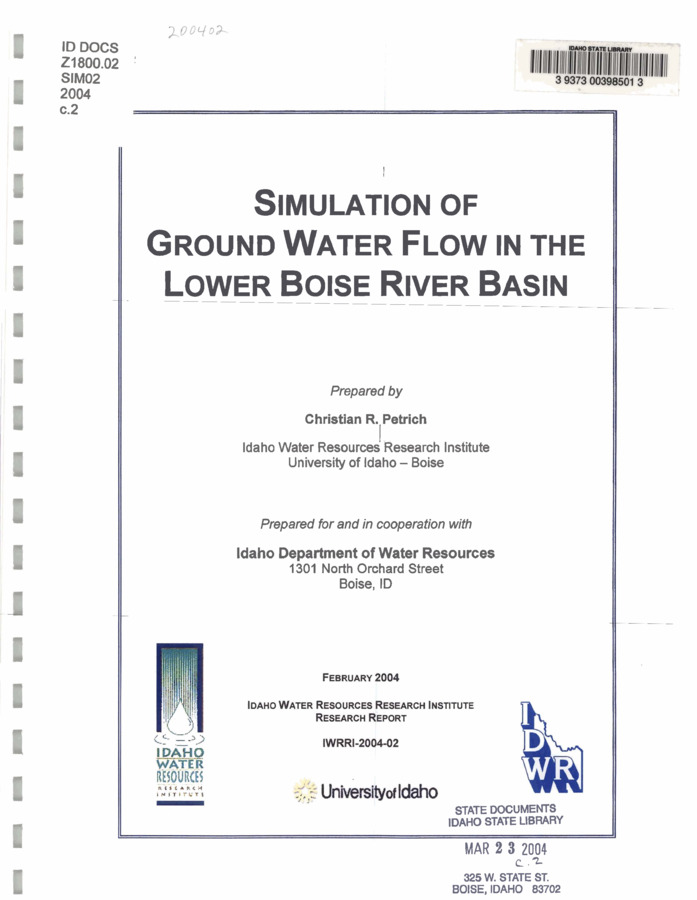PDF
Simulation of groundwater flow in the lower Boise River Basin Item Info
- Title:
- Simulation of groundwater flow in the lower Boise River Basin
- Authors:
- Petrich, Christian R.
- Date Created (ISO Standard):
- 2004-02
- Description:
- The lower Boise River basin (Treasure Valley) aquifer system consists of a series of shallow, relatively high-permeability aquifers and a deeper, regional flow system. A numerical model of regional groundwater flow was developed to evaluate (1) the effects of large-scale increases in groundwater withdrawals on regional groundwater levels and (2) the potential effects of altered recharge rates (associated with conversion of agricultural to urban land use) on regional groundwater levels. The model was constructed using the three-dimensional, finite difference MODFLOW code (Harbaugh et al., 2000; McDonald and Harbaugh, 1988; McDonald and Harbaugh, 1996). The model was calibrated under steady-state hydraulic conditions using the automated parameter estimation code PEST (Doherty, 1998; Doherty, 2000). Horizontal and vertical hydraulic conductivity parameters were calibrated to 200 averaged water level observations and 6 actual and estimated vertical head differences. The model calibrated with higher hydraulic conductivity values in the uppermost aquifer zones, corresponding with known areas of coarser-grained sediments. PEST-calibrated parameter values also indicated relatively high hydraulic conductivity values in areas of the eastern and central portion of the valley associated with fluvial/deltaic deposition. Simulated fluxes between model layers in the base calibration indicated a relatively small amount of water moves vertically between model layers, especially in the lower layers. Based on simulation results, most recharge that occurred in shallow aquifer zones did not reach deeper zones. A 10% increase or decrease in recharge led to minimal changes in water levels or parameter value estimates because shallow groundwater levels in central portions of the basin are controlled, in part, by elevations of surface water channels. Decreased or increased recharge resulted in changes in the rates of water discharging to model drain, general head boundary (Lake Lowell), constant head (Snake River), and river (Boise River) cells. Changes in land use that lead to decreases in shallow-aquifer recharge may not have a substantial effect on shallow groundwater levels until the water table elevations remain below those of nearby surface channels. Simulations indicated that some groundwater level declines might occur with a 20% increase in groundwater withdrawals over 1996 levels. Modest simulated declines were observed in the Boise area in layers 1 and 2. Greater simulated declines were observed in the central portion of the valley (especially in the Lake Lowell area) in layers 3 and 4. The simulated 20% increase in groundwater withdrawals resulted in increased losses from the Boise River (23%), decreased discharge to agricultural drains (62%), and decreased discharge to the Snake River (9%). Simulated water level declines andlor changes in mass balance components reflected a combination of parameter uncertainty and response to a changed hydraulic stress.
- Subjects:
- groundwater flow Boise River Watershed Ada County Canyon County computer simulation
- Location:
- Boise River
- Latitude:
- 43.65
- Longitude:
- -116.44
- Collection:
- Boise Basin
- Series:
- Research Report
- IWRRI number:
- 200402
- Rights:
- In copyright, educational use permitted. Educational use includes non-commercial reproduction of text and images in materials for teaching and research purposes. For other contexts beyond fair use, including digital reproduction, please contact the University of Idaho Library Special Collections and Archives Department at libspec@uidaho.edu. The University of Idaho Library is not liable for any violations of the law by users.
- Publisher:
- Idaho Water Resources Research Institute; University of Idaho
- Contributing Institution:
- University of Idaho
- Type:
- Text
- Format:
- application/pdf
- Cataloger:
- Jodi Haire
- Date Digitized:
- 2011-03-03
Source
- Preferred Citation:
- "Simulation of groundwater flow in the lower Boise River Basin", Idaho Waters Digital Library, University of Idaho Library Digital Collections, https://www.lib.uidaho.edu/digital/iwdl/items/iwdl-200402.html
Rights
- Rights:
- In copyright, educational use permitted. Educational use includes non-commercial reproduction of text and images in materials for teaching and research purposes. For other contexts beyond fair use, including digital reproduction, please contact the University of Idaho Library Special Collections and Archives Department at libspec@uidaho.edu. The University of Idaho Library is not liable for any violations of the law by users.
- Standardized Rights:
- http://rightsstatements.org/vocab/InC-EDU/1.0/

